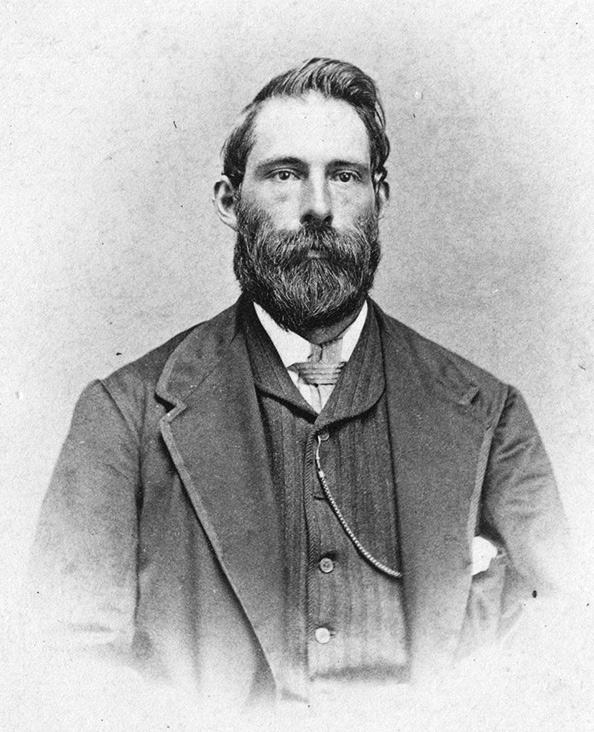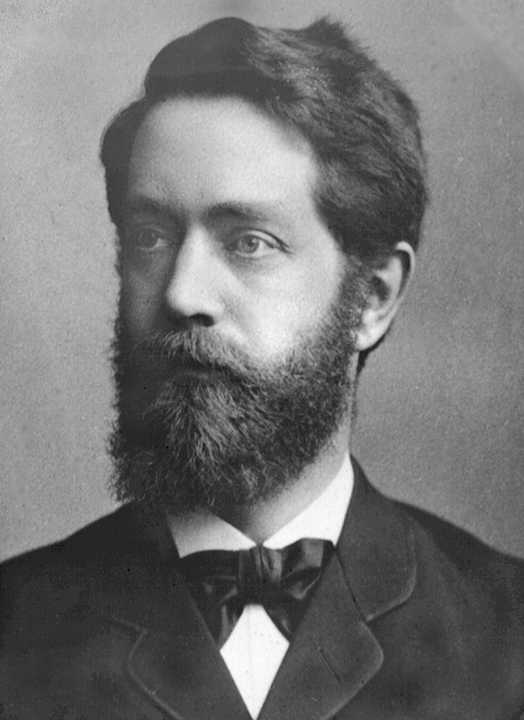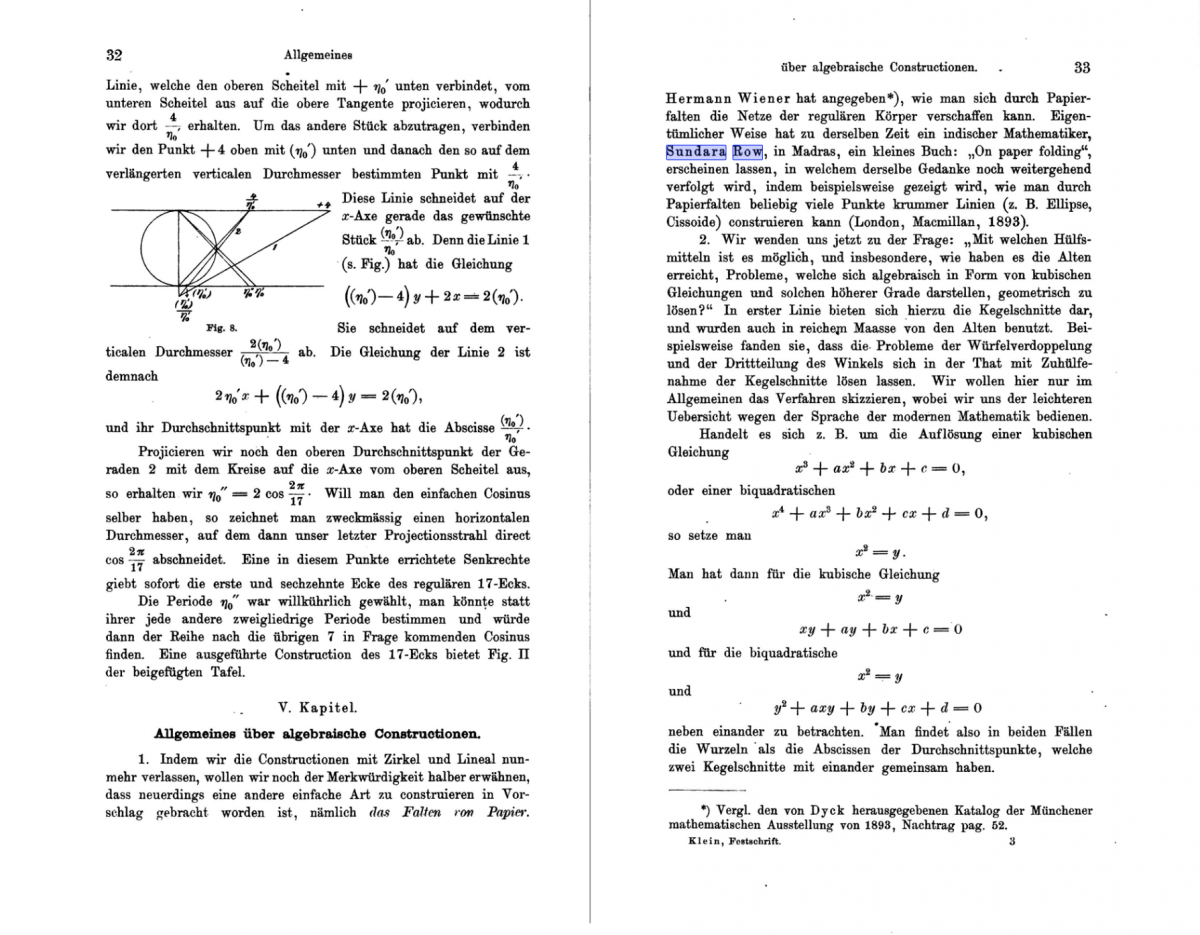- About MAA
- Membership
- MAA Publications
- Periodicals
- Blogs
- MAA Book Series
- MAA Press (an imprint of the AMS)
- MAA Notes
- MAA Reviews
- Mathematical Communication
- Information for Libraries
- Author Resources
- Advertise with MAA
- Meetings
- Competitions
- Programs
- Communities
- MAA Sections
- SIGMAA
- MAA Connect
- Students
- MAA Awards
- Awards Booklets
- Writing Awards
- Teaching Awards
- Service Awards
- Research Awards
- Lecture Awards
- Putnam Competition Individual and Team Winners
- D. E. Shaw Group AMC 8 Awards & Certificates
- Maryam Mirzakhani AMC 10 A Awards & Certificates
- Two Sigma AMC 10 B Awards & Certificates
- Jane Street AMC 12 A Awards & Certificates
- Akamai AMC 12 B Awards & Certificates
- High School Teachers
- News
You are here
Aiding the Teaching of Geometry and Affording Mathematical Recreation: Paper Folding in the Spirit of Sundara Rao of Madras – Rao’s Western Readers
Rao sent a copy of his book to the AIGT, which had recently began publishing a journal entitled The Mathematical Gazette.[11] The December 1894 issue of that serial noted receipt of the book with the comment:
The author has sought, in our opinion with success, “not only to aid the teaching of geometry in schools and colleges, but also to afford mathematical recreation to young and old.” The book should be in the hands of all those who have to introduce geometrical ideas to young pupils. We commend it especially to kindergarten training colleges for teachers [Anonymous 1894].
The remarks quoted are unsigned, but a later postcard indicates they were from the founding editor of the Gazette, Edward M. Langley (1851–1933).[12] That same month, Langley sent a letter to the much better-known journal Nature. Here, he commended teachers who wished to introduce students to geometrical ideas gradually, before exposing them to the full rigors of Euclidean geometry. Langley recommended kindergarten materials as a first step and then listed eight books that might be helpful for further study. One of them was Rao’s Geometrical Exercises [Langley 1894]. Langley’s list inspired another Englishman, Louis C. Miall (1842–1921), to publish his own recommendations on elementary geometry textbooks. This appeared in his 1897 book Thirty Years of Teaching [Miall 1897, p. 118]. Miall too recommended Rao’s book.[13]
Copies of Rao’s book also made it outside the British Empire. An example belonging to the American mathematical journalist Artemis Martin, inscribed with the author’s compliments, is in the library of American University. Rao’s compatriot B. H. Rao had posed a problem in Martin’s short-lived journal The Mathematical Magazine, which might explain why Martin received a copy of the booklet.[14]


Figure 13. Undated photos of Artemas Martin and Felix Klein. Wikimedia Commons and Wikimedia Commons.
Another reader, of far greater importance both to mathematics generally and to the diffusion of knowledge of Sundara Rao’s work, was the German Felix Klein (1849–1925). By 1893, Klein was professor of mathematics at Göttingen University, where he trained a generation of research mathematicians. The summer of that year, he successfully represented German mathematics at an international congress of mathematicians held in Chicago in conjunction with the World’s Fair. Klein also edited the Annalen der Mathematik, a leading German journal. It is possible that Rao sent a copy of his book to Klein directly or to that journal. In the spring of 1895, Klein presented a short series of lectures on famous problems of elementary geometry at the third meeting of the Vereins zur Förderung des Mathematischen und Naturwissenschaftlichen Unterrichts (Association for the Promotion of Mathematics and Science Education), an organization of teachers in German gymnasia (schools). These lectures were based on material he had given previously in short courses at Göttingen, and they were compiled from Klein’s notes by one of the students who had attended a course, F. Tägert.
Klein’s lectures were intended to introduce teachers to the consequences of recent results in geometry for the kind of mathematics they taught. More specifically, he talked about the implications of recent discoveries related to the three problems of classical geometry—the duplication of the cube, the trisection of an angle, and the quadrature of the circle. Ancient geometers strove in vain to solve these problems using only ruler and compass constructions; Klein argued, using algebraic arguments he considered quite elementary, that such solutions were impossible.
Of particular importance to the history of paper folding as a mathematical recreation in the United States is a casual comment at the beginning of the fifth chapter of Klein’s 1895 Vorträge űber Ausgewählte Fragen den Elementargeometrie (Lectures on Selected Questions in Elementary Geometry). The preceding chapter offered a ruler and compass construction of a polygon with seventeen equal sides. Klein’s next topic was to be algebraic constructions, but he first mentioned “a new and very simple method of effecting certain constructions, paper folding” [Klein 1897, p. 42]. He noted that Hermann Wiener, who taught in Darmstadt, had constructed models of the regular polyhedra in this way.[15] Klein also pointed out that, at the same time and in Madras, the Indian mathematician Sundara Row [sic] had worked along similar lines (ignoring Rao’s emphasis on plane figures rather than polyhedra). Klein mentioned Geometrical Exercises in Paper Folding by title and commented that “the author shows how by paper folding we may construct by points such curves as the ellipse, cissoids, etc.” [Klein 1897, p. 42].

Figure 14. Klein’s reference to Row’s Geometrical Exercises in Paper Folding. Internet Archive.
Klein’s lectures struck a chord with at least two American readers. The first was David Eugene Smith (1860–1944) of the Michigan State Normal School in Ypsilanti. Smith published a review of Klein’s Vorträge in the November 1895 issue of School Review, a journal of secondary education associated with the University of Chicago. Smith enthused that the small book “deserves a prominent place in the library of every teacher of elementary geometry.” He went on to comment that:
It is very rare that a man of Professor Klein’s ability in the higher mathematics condescends to take up questions that are quasi-elementary, or, doing so, treats them in a manner at once scholarly and intelligible to those who are not his peers [Smith 1895].
Klein’s short book received a longer and equally enthusiastic review from Charlotte Angas Scott (1858–1931) of Bryn Mawr College, published in the Bulletin of the American Mathematical Society in March 1896. Like Smith—and like Klein himself—Scott emphasized the logical solution of problems in elementary geometry rather than intuitive proofs. Also like Smith, she made no reference to Sundara Row. After a detailed summary of Klein’s book, she suggested that an English-speaking association “would do a service in publishing a thoroughly good translation of this inspiring work and circulating it as widely as possible” [Scott 1896, p. 164]. The British journal Nature gave a summary of Scott’s review in its 9 April 1896 issue. Noting her suggestion that Klein’s pamphlet should be translated, they suggested that she undertake the task [Anonymous 1896].
[11] Edward M. Langley to David Eugene Smith, November 20, 1901, David Eugene Smith Professional Papers (DESPP), Rare Book and Manuscript Library, Columbia University, New York, New York.
[13] Miall claimed he was reproducing Langley’s list, but the books included are not identical.
[14] I thank Susan McElrath of American University for information about the volume in the Artemis Martin collection. For the problem posed to Artemis Martin and his readers by B. H. Rao, see Mathematical Magazine 1, no. 12 (October 1884): 220.
Peggy Aldrich Kidwell (National Museum of American History, Smithsonian Institution), "Aiding the Teaching of Geometry and Affording Mathematical Recreation: Paper Folding in the Spirit of Sundara Rao of Madras – Rao’s Western Readers," Convergence (March 2023)




